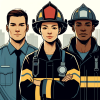Updated September 19, 2017
Almost every fire department that conducts a recruitment process will have some sort of written test included in its process. The written test is used as an initial screen to reduce the number of applicants while ensuring that the group who continues in the process possesses some of the basic minimum competencies required for the job.
Typically, the fire department or human resources department will contract with a test publisher and select a written test. While there are several test publishers to choose from, the skills and abilities measured on the tests are all very similar.
Most firefighter written tests will measure the following skills and abilities: basic reading comprehension, basic mathematical aptitudes, spatial/mechanical skills and writing abilities. In addition to these traditional cognitive components, many test publishers now include additional measures of human relations skills (e.g., teamwork, interpersonal skills, stress tolerance, etc.).
Firefighter written exam tips
The vast majority of the entry-level firefighter written tests on the market do not require any preparation. The tests measure basic skills and abilities that an 18-year-old applicant should already possess. There are steps you can take during the test administration to increase your success on the written test.
1. Arrive early
Show up early on the day of the test. Applicants who are late are often denied permission to take the test. Be sure to bring all materials and/or information that the testing agency requested you to bring. Many testing agencies require that you bring some form of government issued photo identification such as a driver’s license or a state identification card.
2. Come prepared
Failure to bring required materials might result in not being able to take the test. Wear comfortable clothing in layers so you can remove or put on an item of clothing if the room becomes too warm or cool. This strategy will help you to be comfortable throughout the exam. You can also use your sweater or jacket to cushion your seat if it is too hard or uncomfortable. You should also keep in mind that this test is part of the overall selection process. Check with the agency that is administering the test to see if there are any dress requirements.
When you are given the test instructions on the test day, you will be informed how much time you have to answer the questions. Take your watch off and put it on the table where you can see it. This will help you keep track of your time and progress.
You should be supplied with all materials you need to respond on the test, including test answer forms, scratch paper and pencils. Leave all of your test preparation materials or notes outside of the testing area. You may not refer to any other study materials during the test.
3. Mark your answers clearly
Once you begin to take the test, make sure you clearly mark your answers to each corresponding question. If you skip any questions during the test, make sure you continue to put your answers next to the correct answer number on the answer sheet. It is easy to put answers next to the wrong question number on the answer sheet if you do not pay close attention. When you have reached the end of the test, go back and check that you have answered all of the questions.
During the test, you will be instructed to choose the “best” or “most correct” alternative from four to five different options. Read the entire question and all of the alternatives before choosing the best or most correct one. It is better to read all of the alternatives as you may find one that is a better answer than the one you first thought was correct.
If you have time, back and review your answers. You may have recalled something later that may help you to correctly answer earlier questions.
4. Do not leave any answers blank
Most tests are scored on the number of correct answers you give in response to the questions. Very few written tests penalize candidates for guessing and the majority of them will penalize you for any answers left blank. Try to eliminate alternatives that you know are wrong and guess from the ones that remain. This will increase your chances of guessing the correct answer. Answers left blank will not be counted toward the number of correct responses in your final score.
When you answer questions that require you to put yourself in a position and respond appropriately, answer in a way that you think an “ideal firefighter” would respond. The questions will help identify the best candidates who demonstrate solid decision-making and interpersonal skills. When you answer questions that provide you with a rating scales (e.g., a rating scale of 1-4 or 1-5), you are strongly encouraged to use the range of the scale rather than playing it safe and only using ratings near the middle of the scale.
5. Make a good impression
It is important to try to make a good impression throughout the entire testing process. Command level officers and administrators from the department sometimes visit the test site on the day of the test. Horseplay and loud joking before or after the test may create a poor impression of your ability to perform the job of a firefighter. You should remain quiet during the test unless you have permission to do otherwise from administrators.
Implement these strategies and prove to the department, through your behaviors and your test performance, that you are the candidate they need to hire.













